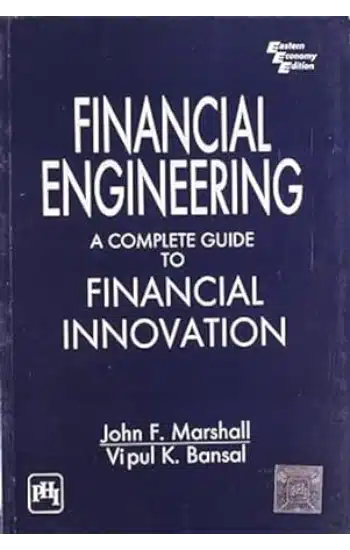
Save: 60%

Save: 50%
Financial Engineering: A Complete Guide To Financial Innovation (Business) 2013
Publisher:
| Author:
| Language:
| Format:
Publisher:
Author:
Language:
Format:
₹495 ₹198
Save: 60%
In stock
Ships within:
In stock
☆ ☆ ☆ ☆
| Book Type | |
|---|---|
| Signs of Wear | |
| Weak Binding | |
| Pages |
Pages are mostly clean with minor marks |
| Pen/Pencil Marks |
Pen and pencil used minimally |
ISBN:
Page Extent:
This is an industry-independent exploration of financial engineering_an area sweeping the world of corporate, bank, and investment finance.From reviewing the basic building blocks of financial engineering to examining the many processes involved in creating innovative financial instruments, this lucid text provides professional advice to custom-tailor the solutions to any organization’s risk-management problems. The text provides illustrative charts, tables, diagrams and fully worked-out examples. Table of Contents Forewords. Preface. SECTION I: OVERVIEW OF FINANCIAL ENGINEERING_An Introduction to Financial Engineering. Factors Contributing to the Growth of Financial Engineering. The Knowledge Base of the Financial Engineer. SECTION II: THE CONCEPTUAL TOOLS OF THE FINANCIAL ENGINEER_Valuation Relationships and Applications. Measuring Return. Risk: Portfolio Considerations, Investment Horizons, Leverage. Measuring Risk: Advanced Topics. Understanding Interest Rates and Exchange Rates. Speculation, Arbitrage and Market Efficiency. The Corporate Treasurer’s Perspective: Reading Between the Lines. SECTION III: THE PHYSICAL TOOLS OF THE FINANCIAL ENGINEER_Product Development. Futures and Forwards. Swaps. Single Period Options: Calls and Puts. Multiperiod Options: Caps, Floors, Collars, Captions, Swaptions, and Compound Options. Fixed Income Securities. Recent Debt Market Innovations. Equity and Equity-Related Instruments. Hybrid Securities. SECTION IV: FINANCIAL ENGINEERING PROCESSES AND STRATEGIES_Asset/Liability Management. Hedging and Related Risk Management Techniques. Corporate Restructuring and the LBO. Arbitrage and Synthetic Instruments. Tax-Driven Deals. Miscellaneous Equity-Based Strategies. SECTION V: FUTURE DIRECTIONS IN FINANCIAL ENGINEERING_Future Trends: Globalization and Technology. Legal Protections for Innovative Financial Products and Services. Index.
This is an industry-independent exploration of financial engineering_an area sweeping the world of corporate, bank, and investment finance.From reviewing the basic building blocks of financial engineering to examining the many processes involved in creating innovative financial instruments, this lucid text provides professional advice to custom-tailor the solutions to any organization’s risk-management problems. The text provides illustrative charts, tables, diagrams and fully worked-out examples. Table of Contents Forewords. Preface. SECTION I: OVERVIEW OF FINANCIAL ENGINEERING_An Introduction to Financial Engineering. Factors Contributing to the Growth of Financial Engineering. The Knowledge Base of the Financial Engineer. SECTION II: THE CONCEPTUAL TOOLS OF THE FINANCIAL ENGINEER_Valuation Relationships and Applications. Measuring Return. Risk: Portfolio Considerations, Investment Horizons, Leverage. Measuring Risk: Advanced Topics. Understanding Interest Rates and Exchange Rates. Speculation, Arbitrage and Market Efficiency. The Corporate Treasurer’s Perspective: Reading Between the Lines. SECTION III: THE PHYSICAL TOOLS OF THE FINANCIAL ENGINEER_Product Development. Futures and Forwards. Swaps. Single Period Options: Calls and Puts. Multiperiod Options: Caps, Floors, Collars, Captions, Swaptions, and Compound Options. Fixed Income Securities. Recent Debt Market Innovations. Equity and Equity-Related Instruments. Hybrid Securities. SECTION IV: FINANCIAL ENGINEERING PROCESSES AND STRATEGIES_Asset/Liability Management. Hedging and Related Risk Management Techniques. Corporate Restructuring and the LBO. Arbitrage and Synthetic Instruments. Tax-Driven Deals. Miscellaneous Equity-Based Strategies. SECTION V: FUTURE DIRECTIONS IN FINANCIAL ENGINEERING_Future Trends: Globalization and Technology. Legal Protections for Innovative Financial Products and Services. Index.
About Author
Reviews
There are no reviews yet.



Reviews
There are no reviews yet.